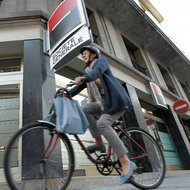 Jacques Brinon/Associated PressA branch of Société Générale in Paris.
Jacques Brinon/Associated PressA branch of Société Générale in Paris.
Paris – The French bank Société Générale announced on Tuesday that it was planning a new-cost cutting drive that would result in hundreds of job losses in France, as its first-quarter net income fell sharply.
The bank said first-quarter net income fell 50 percent, to 364 million euros ($476 million), from the period a year earlier. That was well below the 674.6 million euro profit expected by analysts surveyed by Reuters.
Société Générale, the second-largest French lender, said it planned 900 million euros of cost reductions through 2015, adding to the 550 million euros of cuts last year. Severin Cabannes, the bank’s deputy chief executive, told CNBC television that the bank was in talks with its unions about eliminating 600 to 700 jobs at its headquarters, but added that there would be “no forced layoffs.”
French companies, faced with tough restrictions on firing employees, typically use buyouts and early retirement programs to cut jobs.
Société Générale, based in Paris, said its profit fell largely because it took a charge of around 1 billion euros to revalue the cost of its own debt. The firm’s net banking income fell 19 percent, to 5.1 billion euros.
The bank said that excluding the debt revaluation, legacy assets and one-time charges, it would have had “solid” net profit of 852 million euros. Debt revaluation — in which a bank accounts for changes in the market value of its own debt — flatters a firm’s results when it comes under stress in the market, but makes results appear worse when the debt rises in value.
Société Générale said its corporate and investment banking business, in particular, “turned in a very satisfactory performance.” The unit reported that net income rose 41 percent, to 494 million euros, as the equity division posted strong results as global stock markets rebounded in the first quarter.
Like its larger rival, BNP Paribas, which last week reported a 45 percent decline in first-quarter net income, Société Générale is facing a moribund European economy and a record-high unemployment rate of 12.1 percent in the euro zone. The ongoing slump subdues demand for loans, even as historically low interest rates hold down the profitability of the credit that it does extend to customers.
Société Générale’s chairman and chief executive, Frédéric Oudéa, said in a statement that the bank’s latest cost-cutting plan would help it to generate a return on equity, a measure of profitability, of 10 percent by the end of 2015, compared with 7.4 percent in the first quarter this year.
Mr. Oudéa also said the bank had reached a ‘‘Basel III’’ core Tier 1 capital ratio of 8.7 percent, putting it on schedule to reach the 9.5 percent level that it has targeted for the end of the year. Capital ratios provide an indication of a financial institution’s ability to withstand financial shocks.
While Société Générale announced a new round of cuts on Tuesday, Crédit Agricole, whose first-quarter revenue fell 26 percent, to 3.9 billion euros, benefited from finally shedding its exposure to troubled assets in Greece. Crédit Agricole said net profit rose 51 percent, to 469 million euros.
In February, Crédit Agricole “deconsolidated” Emporiki Bank, based in Athens, cutting 15.5 billion euros of risk-weighted assets from its balance sheet. Crédit Agricole paid 2.2 billion euros for the Greek bank in 2006, but its losses ballooned to well over 5 billion euros as the Greek economy imploded. Crédit Agricole sold Emporiki last year to another Greek lender, Alpha Bank, for a symbolic 1 euro.
Jean-Paul Chifflet, Crédit Agricole’s chief executive, said in a statement that the results reflected “resilient revenues and income in the group’s core businesses, a persistently moderate cost of risk and a steady decline in expenses, in a mediocre economic environment.”
Shares of Crédit Agricole rose 1.2 percent in Paris on Tuesday, while Société Générale shares rose 4.1 percent.
Article source: http://dealbook.nytimes.com/2013/05/07/societe-generale-announces-new-cuts-as-profit-falls-50/?partner=rss&emc=rss
